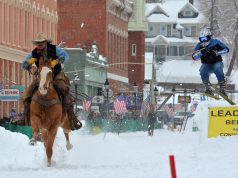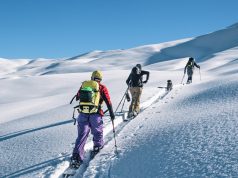
In 1976, Colorado voters were asked a simple question:
“Should the state host the Winter Olympics?” The answer was “no.” The no vote was a shocker. Orchestrated by future governor Dick Lamm, who was a state representative at the time, and fellow rep Bob Jackson, the anti-Olympic movement of the ’70s found sympathetic ears in voters concerned about uncontrolled growth along the Front Range and out of control costs.
For Beaver Creek, the decision to not host the Olympics had profound implications. In 1972, the Olympic Committee had tagged Beaver Creek as the ideal location for the alpine events. There wasn’t a ski area at the mountain, but the potential for a world-class resort was obvious, and Vail Associates (now Vail Resorts) filed for a new ski area permit with the U.S. Forest Service in February of ’72, as Olympic dreams started to dance in their eyes. The no vote hit them like a snowball to the face.
These facts, though, don’t concern us as we step out of the resort’s backcountry access gate and start our hike towards “the bald spot.” The windswept crown above the ski area is a popular destination for skiers, who ski short shots back down into a drainage that feeds back into the resort.
The day has been good, very good. A storm cycle has been dropping six to 12 inches per night over the past three days and we’ve come just as the clouds are starting to lift, the high peaks around us dissolving into view as the sun plays hide and seek. Littered with steep terrain accessed by highspeed lifts and devoid of crowds, we’ve tapped into everything that makes this mountain a local’s secret.
Early turns down the rolling front side terrain of Strawberry Park revealed untracked runs with an optimum pitch. The skiing was fast and smooth before we challenged the steeper bump skiing off of Grouse Mountain.
In the afternoon we hit Stone Creek. Lines through pines and aspens with cliffy entrances destroyed prior notions that Beaver Creek doesn’t play host to any extreme skiing. Again, we’re hiking to the top, beyond the ropes for one last powder run, despite the fact that our legs are screaming for one of the Beav’s impeccable groomers to deliver us to apr%uFFFDs ski.
At the bottom, a few more face shots tallied for the day, we head for the bar, Olympic-sized smiles on our faces. It’s been the perfect day. Plenty of new snow, a bit of sun and hardly any people. The Olympics? Who cares?
Well, plenty of people care, and they’re looking to have Beaver Creek become the Olympic venue that it was always supposed to be. Last winter, the Vail Symposium hosted former Gov. Lamm, Steve McConahey, former chairman of the Denver Metro Sports Commission (the organization leading the effort to bring the Olympics to Colorado) and British Columbia Premier Gordon Campbell for a discussion on whether Colorado should make a bid for the 2022 Olympics. If the bid process goes ahead, Denver would most likely go up against Reno/Tahoe, Salt Lake City and Lake Placid in attempting to receive the backing of the U.S.
Olympic Committee’s blessing in 2013. Salt Lake and Lake Placid have already hosted a Winter Olympics, as did the Lake Tahoe area when Squaw Valley hosted the 1960 Winter Games. And then there’s Colorado’s history: a successful bid that was shot down by the voters back in 1976. Would Beaver Creek’s fate be any different this time?
Truth be told, Beaver Creek already hosts plenty of Olympic athletes. Each year, the men’s World Cup makes a stop in town. The Birds of Prey course was build in 1997 for the 1999 World Championships. Designed by a 1972 Olympic champion, the legendary Italian ski racer Bernhard Russi, the track has won accolades from many of the best in ski racing. Bode Miller has raced in Beaver Creek’s challenging and technical Birds of Prey downhill, finishing first here in 2004. Herman Maier clinched the gold here at the ’99 World Championships. In 2009, three of the best in skiing ended up on Beaver Creek’s podium: Carla Janka, Didier Cuch and Askel Lund Svindal finished one, two, three in the event, with the USA’s Miller in fourth. In 2010, the downhill was cancelled due to weather, but fans were treated to the sight of USA Giant Slalom phenomenon Ted Ligety on top of the podium. Ligety would go on to claim the overall World Cup title for the season.
With this kind of pedigree, it’s likely that the Vail area, and Beaver Creek in particular, would be an integral part of any Colorado Olympic bid. And even Lamm seems to be convinced this time around. “If it’s well-organized and transparent” Lamm would back a bid, he told the Vail Symposium.
But does the state want it? And would the time, money and effort end up landing the Winter Olympics? According to McConahey, Denver has some advantages that make it an ideal location to host the 2022 Games. McConahey says 10 of the 16 venues needed are already in place and the city is close to world-class alpine venues, and both Denver and the mountain resorts can host the thousands of visitors who would come to watch the games.
“I believe firmly these Winter Games can be successful,” says McConahey. He concedes that funding Colorado’s bid will require $15 million to $60 million, no small change in the current economic climate.
That’s a lot more than our apr%uFFFDs ski beers cost. And, as the snowmelt drips from our boots, we don’t spend our time talking about Beaver Creek’s illstarred Olympic past or the potential for an Olympic future on this mountain. Rather, the conversation turns to the things that all skiers and snowboarders truly care about: how there were no lift lines, the hidden slot through the aspens that was untouched until we discovered it, the massive face shots we got on our first run down Grouse Mountain and how it sucked to hike to the Bald Spot but was worth it in the end. And how another beer would taste really, really good right about now.
Respond: [email protected]
Details, details
Scheduled to open Nov. 23, Beaver Creek will host the world’s best ski racers — including many past and future Olympians — at the annual Birds of Prey World Cup, Dec. 2-4. This year’s installment of the venerable event features Downhill, Super G and Giant Slalom events, and is the only domestic stop for the U.S. men’s national ski team. Lift ticket and accommodation info, webcams and trail maps are available at beavercreek.com.














